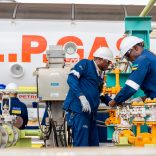Mozambique: TotalEnergies hands over road in Palma
The Inhambane sands: From crafts to home building – Mozambique

Pictures: DW
The Mutamba River sands are critical to the livelihoods of many families in Inhambane. Sands have various uses such as bricks or pots manufacturing, but this exploitation has consequences, both environmental and social.

It all starts here
The Mutamba River in Inhambane is rich in the dark sands used to make bricks and other products. Due to the financial crisis and the lack of alternatives, hundreds of inhabitants of the region have found a means of survival here. There are also more and more minors working in this sector, who are exposed to many dangers, including snake bites.

Environmental hazard
Many families have turned to the Mutamba River to be able to obtain sand and sell it at the workshops. The effects of the destruction of nature are already visible, with holes in the banks of the river. Getrudes Namburete, from Centro Terra Viva, is against the activity. And seasonal exploitation was banned four years ago – only the licensed are allowed [to extract sand]. But the problem remains , with no oversight in this sector.

Workshops
Mutamba River sands are sold at a local workshop. A small bakkie-load of sand costs 275 meticais, about four Euros. Sand exploitation is undertaken on payment of an annual fee of 1200 meticais (18 Euros) to the Provincial Directorate of Mineral Resources and Energy.

The most sought-after brick
Mutamba bricks are highly sought after by people who want to build homes. The owners of tourist resorts in the region also buy these bricks. Those who cannot buy blocks at the workshops usually live in houses made of precarious materials. The price of a Mutamba brick in seven meticais (0.10 Euros) on average.

Family business
José Vilankulo is a native of Jangamo district. He and his wife make bricks for the construction of houses. They learned the art of making bricks from family members. Vilankulo says the business used to be profitable, but in the last three years there have been fewer customers.

The traditional oven
It is possible to make hundreds of bricks in traditional ovens. Not everybody has their own ovens, and many people use traditional third-party ovens for money. Costs were high, but prices have fallen with the economic crisis of recent years.

Making bricks since 2000
Benjamin Samissone has lived in the region for over 18 years. He makes bricks and bakes them. He sells locally and has his own oven, which is in disrepair. He also rents his oven to people who want to bake their own bricks. He produces about 600 bricks per month and currently employs three seasonal workers.

“I stopped studying”
There are two types of workers: seasonal and hired. Seasonal workers receive 1.5 meticais per brick (two Euro cents). Hired workers get a salary of 2,000 meticais per month (30 Euros). Armando Augusto, 20, born in Cumbana, is a seasonal worker and has been in the industry for two years. He left school in grade 8 when he lost his parents. There are many young people like him here.

Transport issues
This is a wagon used to transport bricks. There are few ovens in the area and the bricks have to be moved around. This is one of the means of transport used for short distances.

Wall construction
Due to the high cost of cement, many families have turned to Mutamba bricks to build walls in their backyards, although they are also expensive.

Mutamba vases
Mutamba sand is also used to make vases – a very popular product at domestically, and bought by individuals and large hotels. A vase can cost 1,500 meticais (22 Euros).












Leave a Reply
Be the First to Comment!
You must be logged in to post a comment.
You must be logged in to post a comment.